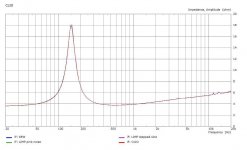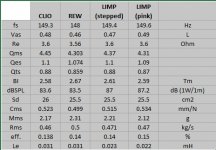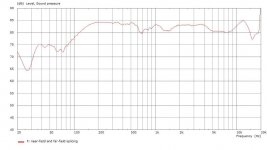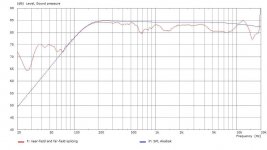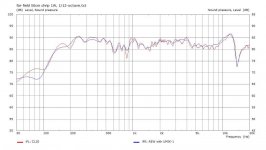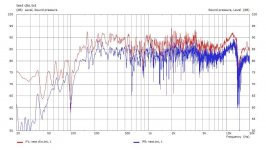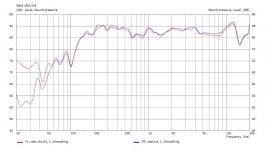I am lucky to have access to a CLIO system (firewire box and CLIO 10 software). This is an expensive tool compared to REW or ARTA plus audio interface. Since high-quality audio interface is relative cheap, together with these low-cost/free software may be able to form a professional measurement system. First, I will do driver impedance and TS parameters using REW and ARTA (LIMP). Obtained results will be compare with CLIO measured data. I will then performance SPL (frequency response) measurment.
All comments are welcome.
All comments are welcome.
hi panson_hk,
interesting, i would like to see it too. How about comparing to omnimic v2? i think its the current golden standard in DIY speakers 🙂
cheers
henry
interesting, i would like to see it too. How about comparing to omnimic v2? i think its the current golden standard in DIY speakers 🙂
cheers
henry
Unfortunately I don't have Omnimic system. But I just ordered a very similar USB mic. This is MiniDSP UMIK-1 for REW and ARTA. I may buy a decent USB audio interface (Presonus) in order to use the CLIO mic with REW and ARTA.
The Peerless (Tymphany) driver is P830985. Data sheet is available from this link http://www.tymphany.com/files/PLS-P830985 Rev1_0.pdf. The one I have showing a higher fs (149 Hz vs 117 Hz given in spec.). It is a big difference!
CLIO SPL (1W/1m) measurement of my sample is given below. The roll-off agrees with the fs measured.
CLIO SPL (1W/1m) measurement of my sample is given below. The roll-off agrees with the fs measured.
Attachments
Last edited:
An update to the last graph to include SPL simulated by Akabak.
A simple Akabak script (sealed box) is as below.
System 'S1'
Def_Driver 'Peerless'
SD=25.967cm2 |Piston
fs=149.3Hz Mms=2.17g Qms=4.45
Bl=2.58Tm Re=3.6ohm Le=31uH ExpoLe=0.618
Driver 'D1' Def='Peerless' Node=1=0=2=3
Enclosure 'E1' Node=2
Vb=877L Qb/fo=0.1 Lb=117cm
Radiator 'Rad1' Def='D1' Node=3
Sd=26.0cm2
A simple Akabak script (sealed box) is as below.
System 'S1'
Def_Driver 'Peerless'
SD=25.967cm2 |Piston
fs=149.3Hz Mms=2.17g Qms=4.45
Bl=2.58Tm Re=3.6ohm Le=31uH ExpoLe=0.618
Driver 'D1' Def='Peerless' Node=1=0=2=3
Enclosure 'E1' Node=2
Vb=877L Qb/fo=0.1 Lb=117cm
Radiator 'Rad1' Def='D1' Node=3
Sd=26.0cm2
Attachments
The differences you show are well withing the usual repeatability range. The driver may need "break in" to meet the original resonance spec.
The quality of the mike calibration and the ability to bring the cal curve into the software may be more important than the software itself.
What was the acoustic environment you measured in? I have had very good results using ground plane windowed measurements to get anechoic measurements. In a large space (empty warehouse space with at least 50' to the nearest object in my case) I can get to below 20 Hz. Averaging multiple measurements helps remove noise a lot.
The quality of the mike calibration and the ability to bring the cal curve into the software may be more important than the software itself.
What was the acoustic environment you measured in? I have had very good results using ground plane windowed measurements to get anechoic measurements. In a large space (empty warehouse space with at least 50' to the nearest object in my case) I can get to below 20 Hz. Averaging multiple measurements helps remove noise a lot.
I notice that Le and dBSPL are the two which are most different. Why is this.... I would think these are the easiest to get right.
Next to the Z and frequency response and T/S parameters, I would be interested in distortion measurements? can you show distortion comparisons. Of course, the mic/preamp etc might be an unknown in the distortion tests.
-RM
Next to the Z and frequency response and T/S parameters, I would be interested in distortion measurements? can you show distortion comparisons. Of course, the mic/preamp etc might be an unknown in the distortion tests.
-RM
Last edited:
Hi Demian,
I will break in the driver and do measurement again.
My environment is not good. It is a small lab room in which 0.5 m far-field with time gating is okay for mid-high frequency band measurement. For low frequency, we do 5 mm near field. I may try measurement in outdoor environment.
I will break in the driver and do measurement again.
My environment is not good. It is a small lab room in which 0.5 m far-field with time gating is okay for mid-high frequency band measurement. For low frequency, we do 5 mm near field. I may try measurement in outdoor environment.
I notice that Le and dBSPL are the two which are most different. Why is this.... I would think these are the easiest to get right.
Next to the Z and frequency response and T/S parameters, I would be interested in distortion measurements? can you show distortion comparisons. Of course, the mic/preamp etc might be an unknown in the distortion tests.
-RM
Efficiency of all calculations are nearly the same. We shouldn't see difference in predicated dBSPL's. I checked REW and LIMP about their TS parameters calculation. It seems LIMP assumes 2.83V for the dBSPL one. Since the driver is 4 Ohm, the number will be 2W/1m. It will be 3 dB more.
I just received minidsp UMIK-1 USB mic. Calibration file of the mic is available from minidsp. In contrast, I don't have an calibration for the CLIO mic. I can only do level calibration for it.
Why REW smoothed out the blue curve vs the red Clio curve? There was some different averaging parameter going on?
REW was set to 256k and single sweep. I did try long and more sweeps (1M, 4). But the result did not change. The CLIO used 16 k chirp sequence, rectangular window and 4 times averaging. It does provide "higher resolution". I have not figured out why.
Why REW smoothed out the blue curve vs the red Clio curve? There was some different averaging parameter going on?
I export raw data from CLIO and REW to text files. The files are imported by VacsViewer in order to use its smoothing function. This can eliminate difference between CLIO and REW smoothing algorithms.
As shown below, we still can see CLIO data is less smooth than that of REW. Do we need to worry about such differences?
I will do distortion next.
Attachments
- Status
- Not open for further replies.
- Home
- Design & Build
- Equipment & Tools
- Comparing REW, ARTA and CLIO in speaker driver and acoustic measurements


